Punjab - Land of Five Rivers
Punjab, with its fertile farming land, is one of India's most prosperous states. Home to bhangra music and the brotherhood of the Sikh religion, it has a distinctive and lively culture. Capital city Chandigarh is a modern day planned city that's different to any other in India. However, to get a real taste of Punjab, it's necessary to venture further afield to discover the simplicity and charm of rural life, amidst an ever growing urban life.
CITIES IN PUNJAB
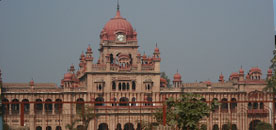
Amritsar :
Amritsar was founded in 1577 by Guru Ram Das, the fourth guru of Sikhs. It’s the spiritual capital of the Sikhs and gained its name, meaning "Holy Pool of Nectar", from the body of water around the Golden Temple. The exquisite Golden Temple attracts pilgrims from all over the world. It looks particularly arresting at night when it’s beautifully lit up, with its imposing pure gold dome illuminated. Prior to the partition of the country, Amritsar occupied an unrivalled position in the business and commercial scene of undivided Punjab. Situated on important trade routes, its trade extends to Kabul, Kashmir and Tibet, even today. Although, the Partition left it a border town and did away with much of its erstwhile importance as a trade center. 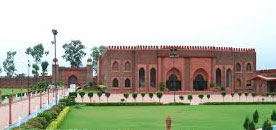
Jalandhar :
Jalandhar is another name of Lord Shiva. Jalandhar is a city in Jalandhar District in the state of Punjab, India and is a municipal corporation in Jalandhar district. It is located 144 km northwest of the state capital, Chandigarh. The city was known as Prasthala in the time of the Mahabharta and as Jullundur in British India. Jalandhar is the 2nd largest seller of vehicles in the State.
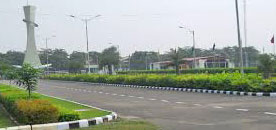
Patiala :
Patiala is the place to come to explore the royal Punjab of the past. Once one of India's richest princely states, Patiala offers a glorious insight into the history of 18th and 19th century Punjab, particularly the Malwa region. You'll be greeted by opulent palace buildings, gardens and parks. Don't miss the Moti Bagh Palace which houses an excellent art gallery, and the imposing 10 acre Qila Mubarak complex with its series of palaces, inner fort, and audience hall. Patiala is also famous for the generous Patiala peg of whiskey, Salwar suits with loose pants, pagdi (traditional turban), and paranda (colorful hair decorations for women). Slip-on leather footwear, known as the Patiala jutti, is another hot item. 
Ludhiana :
Ludhiana is a city and a municipal corporation in Ludhiana district in the Indian state of Punjab. It is the largest city in the state, with an estimated population of 1,613,878 in 2011. The population increases substantially during the crop harvesting season due to migration of laborers from states like Eastern Uttar Pradesh, Bihar, Orissa and Delhi. Ludhiana is located 100 km west from state capital Chandigarh on NH 95 and is centrally located on National Highway 1 from Indian capital New Delhi to Amritsar, and is well connected to New Delhi by road, frequent train service and by air. Ludhiana is also becoming an IT Hub. There are several advanced IT institutes and Finishing schools that provide professional computer education, offering IT Education and Web Development Services]. Students from nearby districts also come to Ludhiana. One can get education in each & every subject on computer stream in Ludhiana.. PILGRIMAGES IN PUNJAB
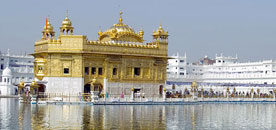
Golden Temple :
Golden Temple, Amritsar Sri Harmandir Sahib, also known as Sri Darbar Sahib or Golden Temple, (on account of its scenic beauty and golden coating for English speaking world), is named after Hari(God) the temple of God. The Sikhs all over the world, daily wish to pay visit to Sri Amritsar and to pay obeisance at Sri Harmandir Sahib in their Ardas. Its architecture represents a unique harmony between the Muslims and the Hindus way of construction work and this is considered the best architectural specimens of the world. It is often quoted that this architecture has created an independent Sikh school of architecture in the history of art in India. 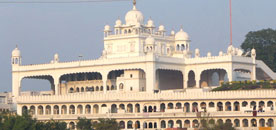
Anandpur Shahib :
The Sikh religion, which originated in Punjab, is based on the teachings of Guru Nanak, and is conceived as a monotheistic faith, whose adherents, the Sardars, at present can be found all over India and abroad too. Its insistence on the universal cult of brotherhood, its plea for equitable social and spiritual liberties for all types of men, its emphasis on the service of man on the road of strong moral codes and, above all, its recognition of the divinity of man and the need of meditation have made Sikhism a subject of great interest across the world. All Sikhs venerate the Guru Granth Sahib, a holy book that contains 'Gurbani', the preaching of Guru Nanak. 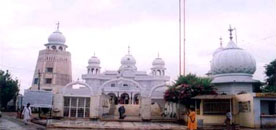
Gurudwara Damdama Sahib :
Takhat Sri Damdama Sahib, Talwandi Sabo, Bhatinda, is the fifth seat of the authority of Sikhs. This place owes its importance to the literary work of Guru Gobind Singh Ji done here during his stay in 1706. It was at Damdama Sahib that Guru Gobind Singh Ji prepared the revised & authentic version of the Adi Granth, which is now being honored by the Sikhs as Guru Granth Sahib ji. He added to the original version prepared by Guru Arjan Dev Ji the verses of Guru Teg Bahadur Ji. A large number of new converts joined the fold of the Khalsa here. Guru Gobind Singh Ji stayed at Damdama Sahib for nearly a year. 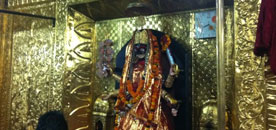
Kali Devi Temple, Patiala :
Situated opposite Baradari garden on the Mall Road of Patiala, this temple was built by the rulers of the Patiala State. The sacred sanctorium of the "Kali Devi Temple" bears relics to the rich art and architecture of the ancient times. Apart from the splendid architectural edifice, the walls of the temple have beautiful mural paintings and sceneries that add to the grace of the monument, so much so that it has been adjudged as a "national monument". The wonderful architectural creation coupled with an aesthetic appeal of the "Kali Devi Temple" is pretty awe inspiring for the tourist who throng the holy shrine in search of eternal happiness. MAJOR ATTRACTIONS
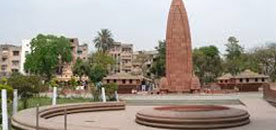
Jallianwala Bagh :
Jallianwala Bagh is a public garden in Amritsar in the Punjab province of India, and houses a memorial of national importance, established in 1951 to commemorate the murder of peaceful celebrators on the occasion of the Punjabi New Year on April 13, 1919 in the Jallianwala Bagh Massacre. Official British Raj sources placed the fatalities at 379, and with 1100 wounded. Civil Surgeon Dr. Smith indicated that there were 1,526 casualties.The true figures of fatalities are unknown, but are likely to be higher than the official figure of 379. The 6.5-acre (26,000 m2) garden site of the massacre is located in the vicinity of Golden Temple complex, the holiest shrine of Sikhism. 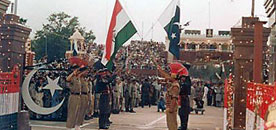
Wagah Border :
The Wagah border, often called the "Berlin wall of Asia", is a ceremonial border on the India–Pakistan Border where each evening there is a retreat ceremony called 'lowering of the flags', which has been held since 1959.At that time there is an energetic parade by the Border Security Force (B.S.F) of India and the Pakistan Rangers soldiers. It may appear slightly aggressive and even hostile to foreigners but in fact the paraders are imitating the pride and anger of a Cockerel. Troops of each country put on a show in their uniforms with their colorful turbans. Border officials from the two countries sometimes walk over to the offices on the other side for day to day affairs. The happenings at this border post have been a barometer of the India-Pakistan relations over the years. 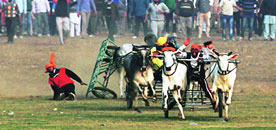
Kila Raipur :
The Kila Raipur Rural Olympics is a rural sports festival that's grown over six decades, to become a sports bonanza that attracts competitors from around the globe. Held for three days during February each year, over 4,000 sports men and woman participate in the festival. They're watched by around 1 million spectators. Bullocks, camels, dogs, mules, and other animals competing in highly professional events must be seen to be believed!The adrenaline-pumping bullock cart race is the main attraction, with sponsored prize money worth a couple of 00 rupees). Other events that are big on entertainment include a dog race, horse dance, camel race, tractor race, and a tug-of-war. But the chance to see some really off-beat activities is the hugest drawcard -- such as people lifting bicycles with their teeth, pulling cars with their teeth or ears, or riding a bicycle ringed with a burning tyre, and other daredevil stunts. The Rural Olympics really is a test of endurance, skill and strength!
